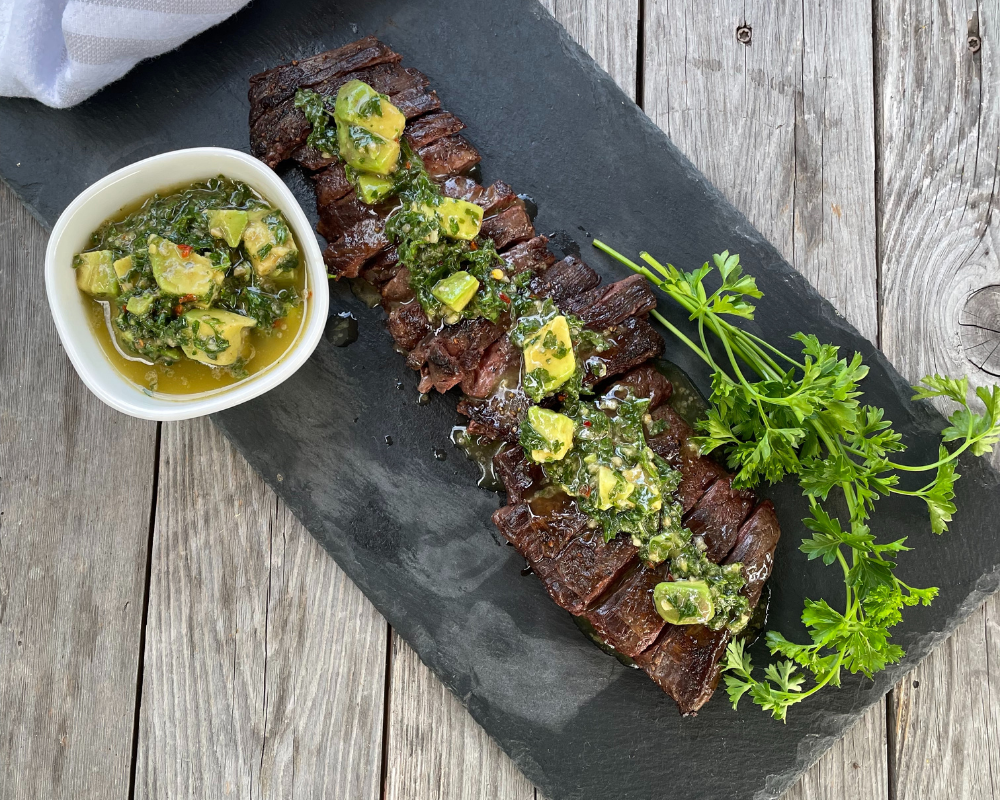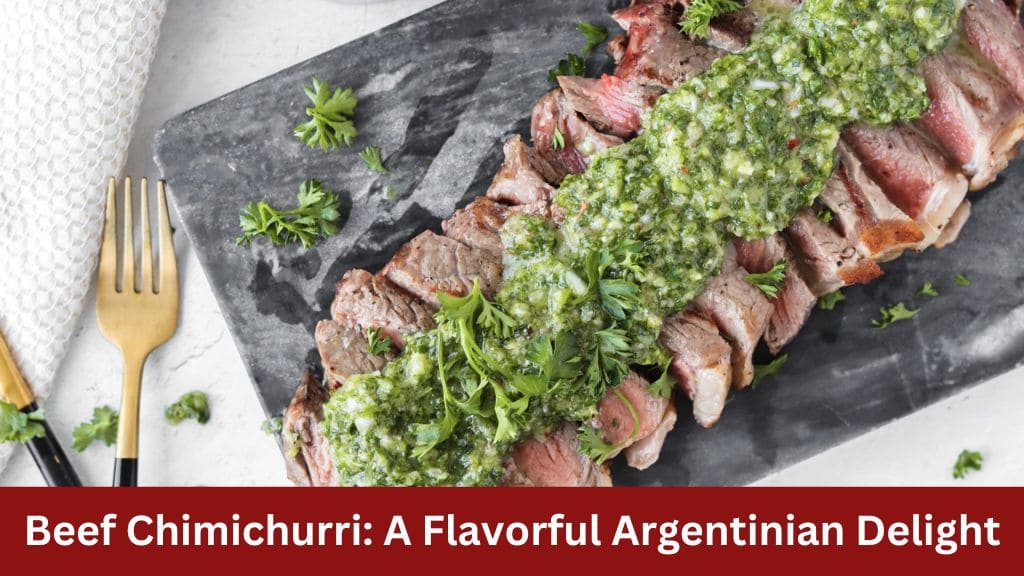Beef Chimichurri is a mouthwatering dish that brings together the rich flavors of grilled beef with the zesty freshness of chimichurri sauce. Originating from Argentina, this dish has gained popularity worldwide for its simple yet irresistible taste. In this blog post, we will explore the history of beef chimichurri, its ingredients, cooking methods, and variations, along with a step-by-step recipe to recreate this culinary masterpiece in your own kitchen.
The roots of beef chimichurri trace back to Argentina, where it is considered a staple in the country’s culinary repertoire. The exact origins of chimichurri sauce are debated, with some attributing it to Argentine gauchos (cowboys) who created it as a marinade for their grilled meats. Others believe it has its roots in the flavors brought by European immigrants to Argentina in the 19th century. Regardless of its precise origins, chimichurri sauce has become synonymous with Argentine cuisine and is now enjoyed worldwide.
Ingredients

To make beef chimichurri, you’ll need the following ingredients:
For the Chimichurri Sauce:
- 1 cup fresh parsley leaves, tightly packed
- 1 tablespoon fresh oregano leaves, tightly packed (optional)
- 4 garlic cloves, minced
- 1-2 teaspoons red pepper flakes (adjust to taste)
- 1/4 cup red wine vinegar
- 1/2 teaspoon salt
- Black pepper to taste
- 1/2 cup extra virgin olive oil
For the Beef:
- 700g flat iron, flank, or skirt steak, at room temperature
- Salt and pepper to taste
Cooking Method

1. Preparing the Chimichurri Sauce
- Ingredients Preparation: Gather the fresh parsley leaves, oregano (if using), garlic cloves, red pepper flakes, red wine vinegar, salt, pepper, and extra virgin olive oil.
- Blending Process: In a food processor, combine the parsley, oregano, minced garlic, red pepper flakes, red wine vinegar, salt, and pepper. Pulse the mixture until the ingredients are finely chopped but not completely pureed.
- Emulsifying the Sauce: While the processor is running, slowly drizzle in the olive oil until the sauce achieves a smooth and cohesive texture. This emulsification process helps bind the ingredients together and enhances the overall consistency of the chimichurri sauce.
- Resting Period: Transfer the chimichurri sauce to a bowl and let it rest for at least an hour before serving. This allows the flavors to meld together and intensify, resulting in a more vibrant and complex taste profile.
2. Cooking the Beef
- Seasoning: Before cooking, ensure that the beef steak is at room temperature. Generously season both sides of the steak with salt and pepper. This step is crucial for enhancing the natural flavors of the meat.
- Preheating the Grill or Skillet: Whether using a grill or skillet, preheat it over high heat. A hot cooking surface ensures that the steak develops a flavorful crust while sealing in the juices.
- Grilling/Skillet Cooking: Place the seasoned steak onto the preheated grill or skillet. Cook the steak for approximately 2-3 minutes per side for medium-rare, adjusting the cooking time according to your desired level of doneness. For a beautifully charred exterior and juicy interior, avoid overcrowding the cooking surface and refrain from flipping the steak too frequently.
- Resting Period: Once the steak is cooked to your preference, remove it from the heat and transfer it to a clean plate. Allow the steak to rest for 5-10 minutes before slicing. This resting period allows the juices to redistribute within the meat, resulting in a tender and succulent texture.
3. Serving
- Slicing the Steak: Using a sharp knife, thinly slice the rested steak against the grain. Slicing against the grain helps break down the muscle fibers, resulting in a more tender and enjoyable eating experience.
- Plating: Arrange the sliced beef on a serving platter or individual plates. Spoon a generous amount of chimichurri sauce over the sliced beef, ensuring that each piece is thoroughly coated.
- Accompaniments: Serve the beef chimichurri with your choice of side dishes, such as roasted vegetables, crispy potatoes, or a fresh green salad. The vibrant flavors of the chimichurri sauce complement a wide range of accompaniments, allowing for a versatile and satisfying meal.
Variations
1. Cilantro Chimichurri

- Flavor Profile: Substitute parsley with fresh cilantro to add a vibrant and herbaceous twist to the traditional chimichurri sauce.
- Preparation: Follow the same steps as the classic chimichurri sauce recipe, replacing parsley with an equal amount of cilantro. Adjust the remaining ingredients to taste, maintaining the balance of flavors.
- Usage: Cilantro chimichurri pairs exceptionally well with grilled meats, seafood, and vegetables, offering a refreshing and aromatic complement to the dish.
2. Spicy Chimichurri

- Flavor Profile: Infuse the chimichurri sauce with extra heat by incorporating additional red pepper flakes or fresh chili peppers.
- Adjustment: Increase the quantity of red pepper flakes or finely chopped chili peppers in the chimichurri sauce according to your desired level of spiciness. Taste the sauce as you go to achieve the perfect balance of heat and flavor.
- Versatility: Spicy chimichurri adds a fiery kick to grilled meats, enhancing the overall flavor profile with its bold and invigorating heat.
3. Citrus Chimichurri

- Flavor Profile: Introduce a bright and tangy element to the chimichurri sauce by incorporating lemon or lime zest and juice.
- Enhancement: Add freshly grated lemon or lime zest along with a squeeze of juice to the classic chimichurri sauce recipe. The citrusy notes uplift the flavors of the sauce, imparting a refreshing and zesty character.
- Pairing: Citrus chimichurri pairs beautifully with grilled chicken, seafood, and salads, offering a burst of freshness and acidity to the dish.
4. Avocado Chimichurri

- Flavor Profile: Elevate the creaminess and richness of the chimichurri sauce by blending ripe avocado into the mixture.
- Incorporation: Add ripe avocado chunks or mashed avocado to the classic chimichurri sauce recipe and blend until smooth and creamy. Adjust the consistency with additional olive oil if needed.
- Texture: Avocado chimichurri adds a luscious and velvety texture to the sauce, enhancing its mouthfeel and making it ideal for drizzling over grilled meats, tacos, or sandwiches.
Experimentation and Creativity:

- Customization: Feel free to mix and match ingredients to create your own unique variations of chimichurri sauce. Incorporate fresh herbs like basil, mint, or dill for added depth of flavor, or experiment with spices such as cumin, coriander, or smoked paprika for a different twist.
- Taste Testing: Don’t be afraid to taste and adjust the seasoning as you go. The beauty of chimichurri sauce lies in its versatility and adaptability to individual preferences.
- Exploration: Keep exploring new flavor combinations and techniques to elevate your beef chimichurri experience and discover endless possibilities for culinary creativity.
Conclusion
Beef chimichurri is a delectable dish that showcases the vibrant flavors of Argentine cuisine. With its simple yet robust combination of grilled beef and zesty chimichurri sauce, it has become a favorite among food enthusiasts worldwide. Whether you’re hosting a backyard barbecue or preparing a weeknight dinner, beef chimichurri is sure to impress with its bold flavors and irresistible aroma. Try out this recipe and embark on a culinary journey to the heart of Argentina from the comfort of your own kitchen. Buon appetito!


:max_bytes(150000):strip_icc()/Grilled-Skirt-Steak-with-Mustard-Green-Chimichurri-FT-RECIPE1023-a35c562d87b34d45b799017f453044ad.jpg)



